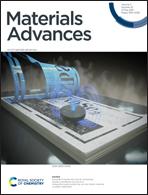Translation of a chemical reaction to electrical signal generation: an organic–inorganic complexation strategy†
Abstract
A complexation strategy involving the addition of cysteine to a Cu(I)–polyaniline composite system, where cysteine performed the role of a ligand, has been reported. The in situ electrical measurement of the complexation process exhibits a resistive switching behaviour with an ON-to-OFF ratio of 5 × 102 and follows the Ohmic and Poole–Frenkel emission mechanism for the low-conductance state and Ohmic behaviour for the high-conductance state, with a volatile resistive switching property. Further, the polyaniline-stabilized copper sulfide nanoparticle-based device (where cysteine acts as the sulphur source) exhibits a bipolar resistive switching behaviour, where the low conductance state follows the Poole–Frenkel emission mechanism and the Ohmic mechanism was observed for the high conductance state. The device exhibits excellent endurance and retention capacity for 2 × 103 cycles with an average ON-to-OFF ratio of 104, with a non-volatile resistive switching behaviour.



 Please wait while we load your content...
Please wait while we load your content...